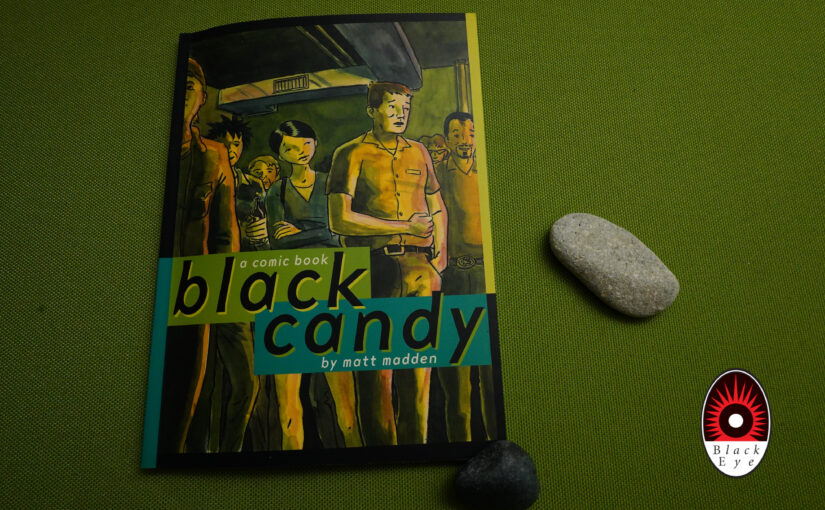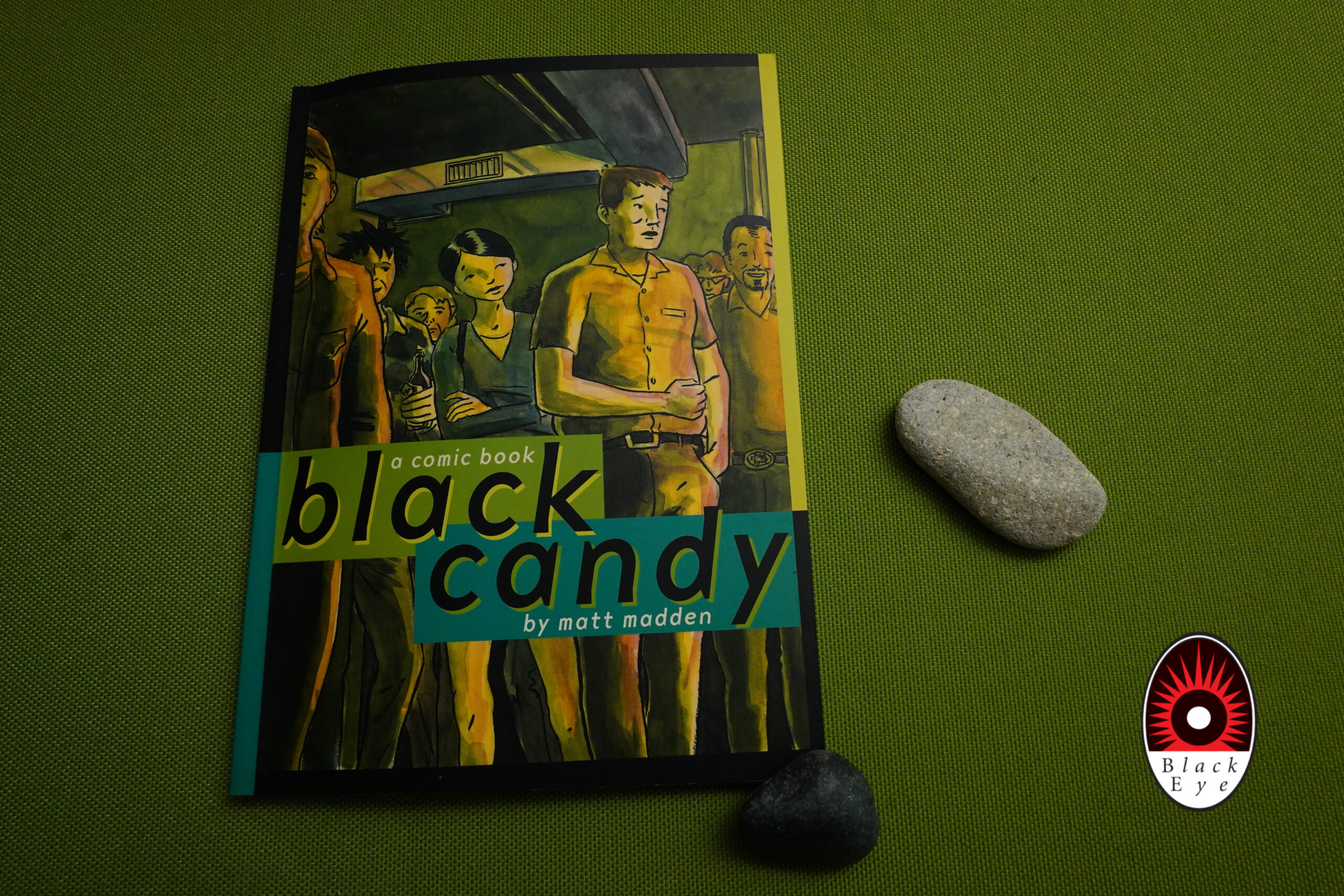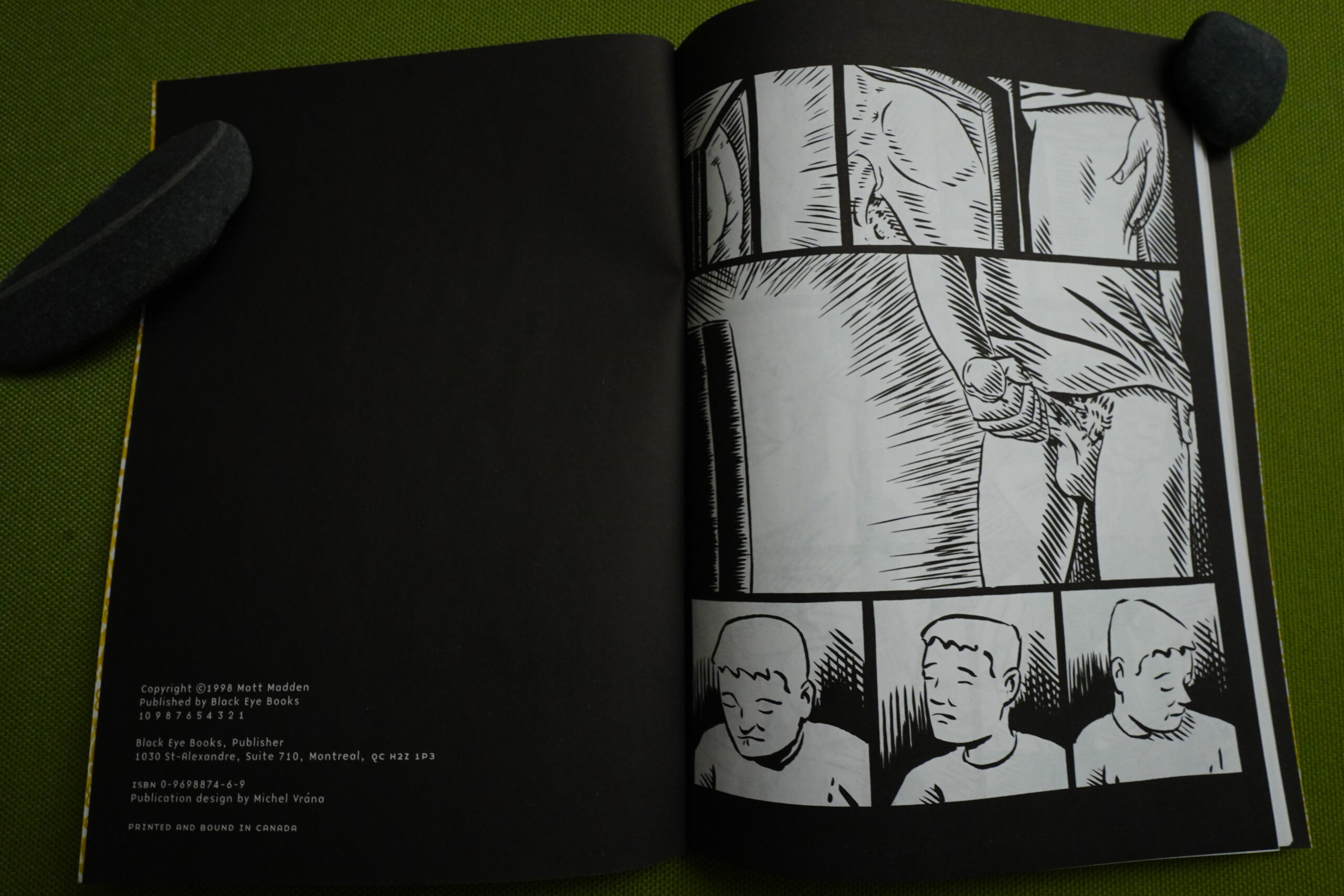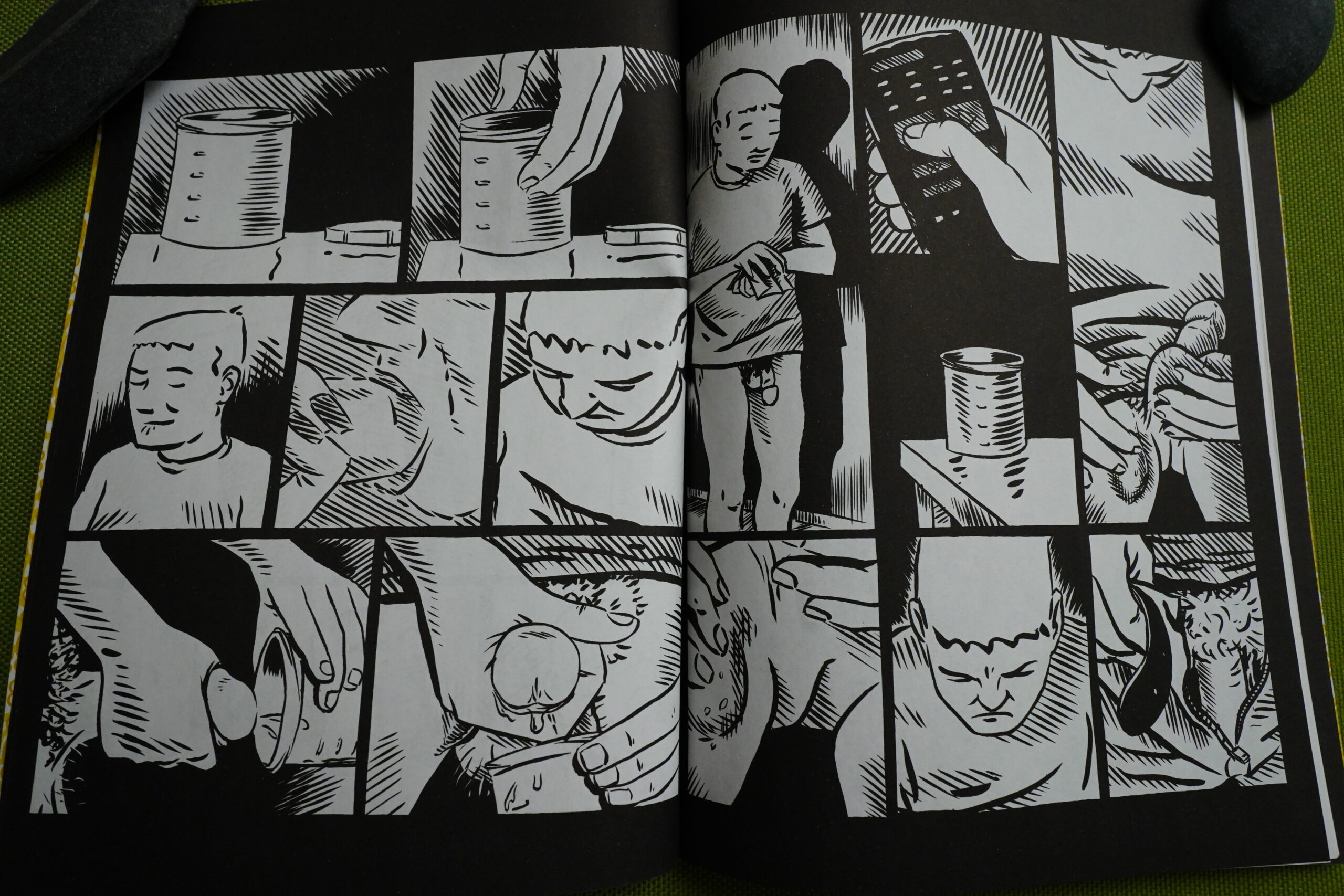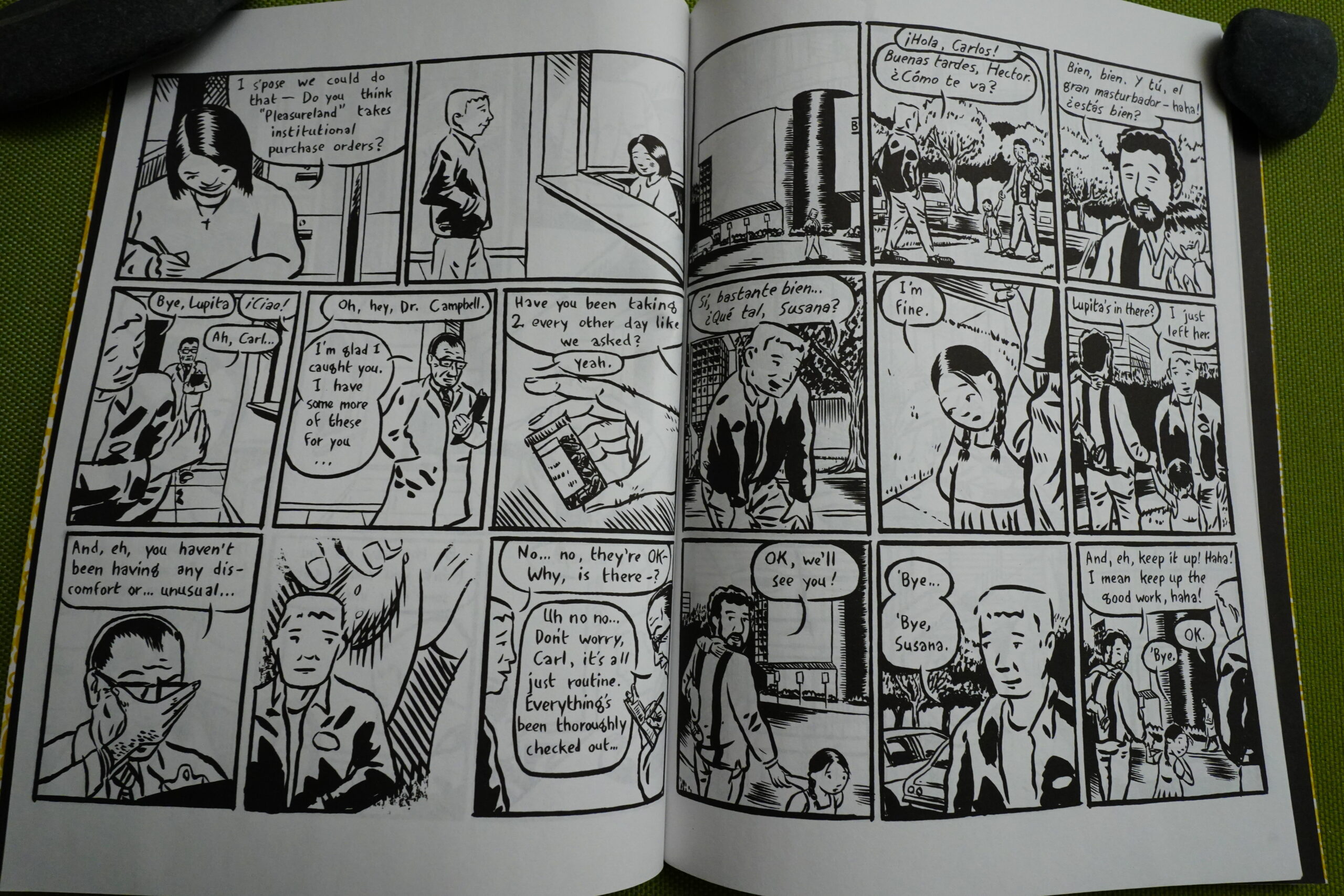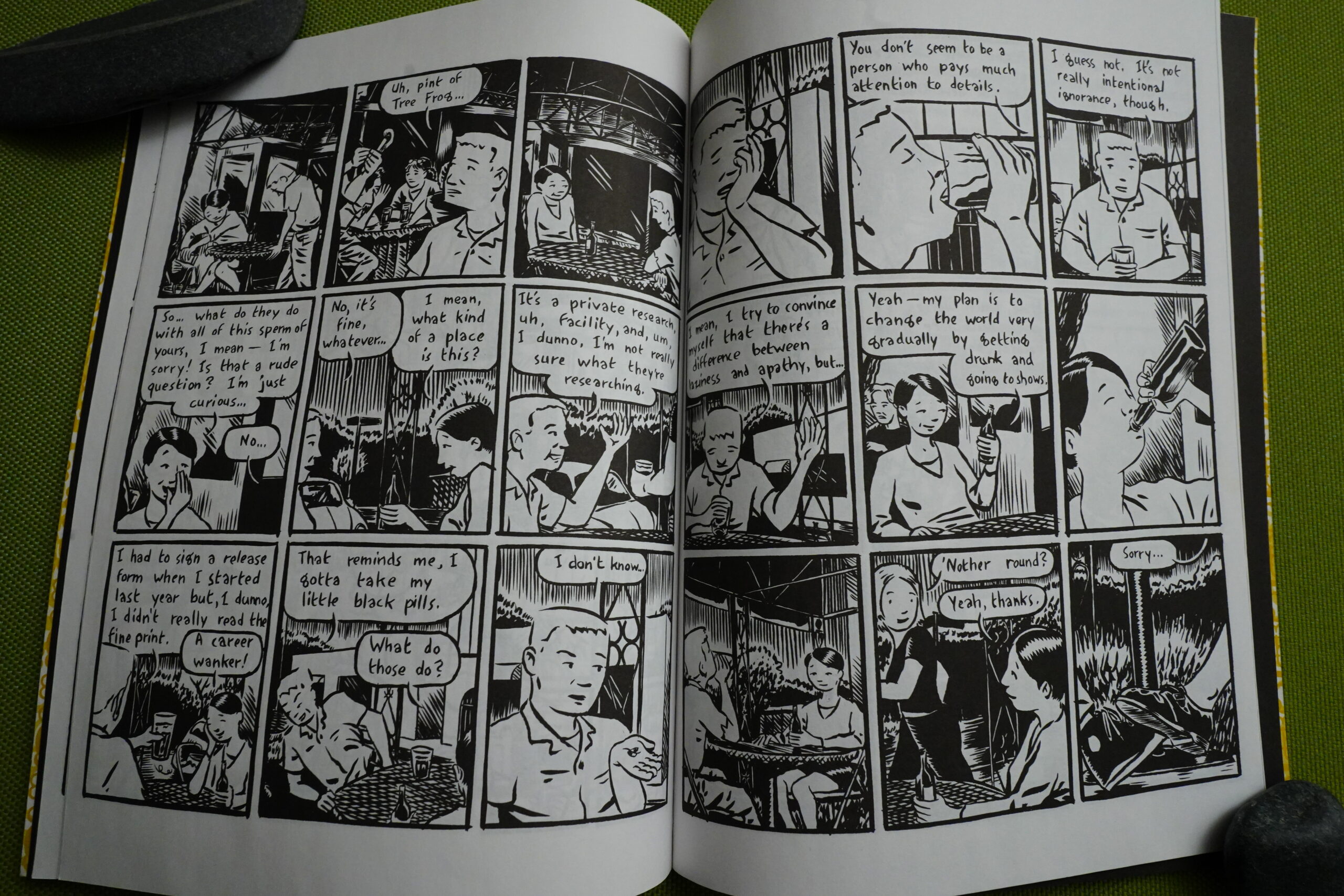Black Candy (1998) by Matt Madden
Matt Madden! That’s a name I sort of vaguely remember, but have extremely positive vibes about… I don’t remember this book at all, though.
Oops! Do I remember how to censor things on this blog… This blog was censored from linking from Facebook for over a decade, and that’s presumably because of some of the comics I’ve posted snaps from over the years…
Yeah, it’s ‘class=”redact”‘. There we go — you have to hover over the pictures to see them, because they will surely destroy civilisation otherwise.
But that’s certainly a way to start a comic! Very in your face, so to speak.
There’s some superficial similarities to some of Charles Burns’ work, I guess — a sort of sex/body horror thing going on, but it’s a lot less mystifying than Burns is. And the artwork rather reminds me of David Mazzucchelli, especially in his City of Glass period.
It’s really good! It doesn’t fall into the trap of trying to explain things too much, but instead goes for, like, confusion and despair.
And it feels like exactly the perfect length, too.
Unfortunately, it hasn’t been reprinted? That’s a shame.
Tom Spurgeon writes in The Comics Journal #199, page #8:
“This is my first attempt to create a
sustained narrative, so a lot of it is
sort of stretching my wings.” says
Madden. “I’d say I was more con-
cerned With pace and mood than
anything else. I was trying to
ture some sense Of daily life (as my
friends and I experience it) being
ruptured by the absurd and
tesque.” Madden, known in his
previous work for a “slice •f life”
approach, isn•tstrayingtoo farfrom
those roots with this latest work
Black Candy draws from real life
situations — the story was initially inspired by a “sperm donors needed” ad in a newspaper — and from there touches on themes including, according
to Madden. “reproduction, parenting, sexuality and the male body flow.” Madden warns that potential readers don’t have to worry about being lectured.
saying he actually followed a very casual artistic approach in working with the material. “I let the themes [in Black Candyl develop at a pretty organic or
unconscious level. I was more interested in just writing the story. then going back and looking at the issues it raises.” Additionally. Black Candy may have
specific resonance for readers in college towns, as Madden drew on Stays in Austin and Ann Arbor, Michigan in completing the work.[…]
Madden hopes that Black Candy will be the first in a series of larger, self-contained works. “l prefer to do longer stories and publish them as
complete books after the European model,” says Madden. The cartoonists notes that a lot of what is in his current offering may set a tone in other
ways. also think that a lot of the concerns in Black Candy— e.g. , formal playfulness, quasi-naturalistic dialogue, episodic structure — will continue
to be present in my future work.”
For now, however, fans will content themselves with Black Candys studied. masterful pace and deeply disturbing subtexts. Like any other “rookie”
with 10 years of experience. Matt Madden will almost certainly take a significant percentage of the comics-reading public by surprise.
Charles Hatfield writes in The Comics Journal #206, page #40:
Matt Madden’s Black Candy begins with
masturbation and ends with cremation.
The end follows logically from the begin-
ning, a direct result. In between, the pro-
tagonist “Carl” (i.e., man) endures betrayal
by his own body, hinted at in small, dark
lumps sprouting in his armpit and groin.
“Some kind Of VD,” he reasons, but we
know better: the lumps must have some-
thing to do with the little black pills he’s
been swallowing.
If this sounds disturbing, it should.[…]
Lyrically, Black Candy succeeds in con-
juring mistrust and horror of the body;
narratively, however, it cheats. Plot-wise,
the story yawns wide open and never
closes: Madden ends up relying on a gnaw-
ing suggestiveness rather than full, fair
disclosure. Though the ending earns
grudging admiration for symbolic fit —
the metaphorical significance of the physi-
cal body is played out with an awful final-
ity — it is not motivated logically. If only
it were more carefully anchored.
In sum, Black Candy is a provokingly
evasive story, anchored in realism, au-
thenticated by sharp observations of the
everyday world, and compromised by grim
fantasy. Kudos is due for Black CandYs
looming sense of foreboding and stark
technique; and criticism for an ending
stacked with too many unfulfilled prom-
ises. The novella begins in a dark room,
and ends by taking a walk on the wild side
of speculation. Though Madden excels at
queasy suggestion and quietly modulated
menace, he fumbles the close, as if unwill-
ing to shoulder the expository burden
demanded by his fantastic premise. For all
its advances in craft, Black Candydoes not
pack the same punch as the less elaborate
(and, to be fair, less ambitious) Fair Warn-
ing, in which the disturbing elements are
more in sync with Madden’s low-key real-
ism.
Or so I would argue. Let the debate
commence, confident of Madden’s prom-
ise — Black Candy is worth arguing about,
and Madden’s name should register deeply
with readers. He demands, and delivers,
much. On the strength of this book, I await
his next.
Well, OK.
Anyway, this is the last comic I’ll be covering in the series that was published by Black Eye’s 90s incarnation. I don’t think this was the final thing they published — that might have been The Sands? But the chronology is a bit uncertain here. But in any case, that means that I have to cover Black Eye’s original demise now, so:
The Comics Journal #203, page #20:
The financial and production prob-
lems that forced Black Eye to cease
publishing for several months have
led two of its artists to seek homes at
other publishing houses and have
caused Black Eye publisher Michel
Vrana to rethink his future publishing
strategy by focusing almost exclu-
sively on collections and graphic
novels. From October Of last year to
this spring, Black Eye, which is run
solely by Vrana, was unable to print
its scheduled books (save for one issue
ofJason Lutes’ Berlin); the dormancy
stemmed in part from financial
troubles that began plaguing Black
Eye when Capital City Distribution
went out of business in July 1996, as
well ai time constraints placed on
Vrana when he took a full-timejob as
a graphic designer. The instability at
the company led bothJames Kochalka
and Megan Kelso to pull their books
from the Black Eye line, and reports
surfaced that some stores and dis-
tributors attempting to order books
from the company were getting no
response. In the wake of frustrations
voiced by some of the artists pub-
lished by Black Eye, Vrana has stated
that he is committed to continuing
publishing but is unlikely to publish
be
comics in serial form for the moment,
With the exception Of Berlin.Vrana conceded that he had over-
extended himselfat times by trying to
juggle the duties of operating a one-
man publishing house while taking
on a fill-time job designing maga-
zines. When he began publishing,
Vrana said he was able to devote the
majority of time to Black Eye while
receiving additional money from
freelance design work. By the end Of
1997, he said, “things were difficult
financially” and his fill-time day job
“put a lot ofstrain on things.”
“Being young and overconfident,
I didn’t see any problem with taking
on a full-time job,” Vrana said.
found myself at times unable to do
production on books that had to get
out… I owed lots of money to lots of
people” and had to hold off on pub-
lishinguntil debts to places like printers
could be paid off.For some ofthe artists associated
with Black Eye, the Small press Expo
in Bethesda, Mary. , last September
was something of a watershed for
their frustrations with the company,
in part because ofa lack ofcommu-
nication on the part Of Vrana.
According to James Kochalka, his
book Quit Your Job was first slated to
come out from Black Eye in August,
and was then was pushed back to
come Out in September for SPX.
Unfortunately, the Black Eye artists
found out when they arrived there
that the Black Eye books slated to
debut at the event had not gone to
press, and the rest of the Black Eye
books had also failed to arrive.
“All [the Black Eye] artists were
there, and they were all grumbling,
and [Vrana] wasn’t there” — which
gave them plenty of time to voice
their frustrations, Kochalka said. For
Ed Brubaker, whose Lowlife was seri-
alized by Aeon and collected in the
Black Eye book Complete
“SPX was kind of like the really big
deal… (Sands creator] Tom [Hart]
andJason [Lutes] basically killed them-
selves to get their books out for SPX
and the books just didn’t come out.”
Brubaker added that because Vrana
(who told the Journal that he couldn’t
afford to fly outto SPX) “waited until
the last minute” to have the Black
Eye backlist books shipped overnight
to SPX from a warehouse, a subse—
quent shipping error delayed the
arrival of the books until the second
day of the convention. Brubaker said
that he had to personally call the
holding area in Baltimore, Where the
books were incorrectly scheduled for
delivery two days after SPX, in order
to get someone to drive the Black Eye
books to SPX. “Michel knew about
all this at least a week or two before
the convention and waited until if
they fucked up, it would be too to
fix it,” Brubaker said.
. If you’re
going to be the publisher, you can’t
rely on everyone else to do every-
thing at the last minute.”
After SPX, Kochalka found his
book delayed yet again when Quit
Your Job was sent to the printer in
N ovember but was not printed due to
Vrana’s outstanding debt. “That was
pretty much the cue for me,” said
Kochalka, who submitted the book
to another publisher, Alternative Press,
which is scheduled to ship it in June.
“I was absolutely sure that I did not
want to give him another book and
then not have it come out,” he said.
Kochalka also rescinded another book
which he had offered to Black Eye
(Tiny Bubbles) and is now publishing
the project with Highwater Books.
“My only problem [with Black Eye],
Kochlaka stated, was having his book
“constantly delayed through no fault
of mine… I really like
Michel and Black Eye as
a company.”
Kelso, who decided
not to publish her Girlhero
comic with Black Eye,
also emphasized that she
did not harbor any “ill
will” towards Vrana. “l
just sort of looked at the
situation [with Vrana’s
new job] and I saw what
everybody else saw —
that everything was
coming outlate, ifatall…
and it just seemed like
[Vranal was really busy,
that he didn’t have time
to put my book out… I
just told him that it
seem like a good time
[for Black Eye to publish
Girlherol.
While Brubaker
echoed Kelso and
Kochalka’s personal as-
sessment of Vrana, he cited
additional frustrations about reports
that stores who were attempting to
order his Lowlife collection found
Black Eye unresponsive. Brubaker
told the Journal that a few retailers
had complained to him personally
about the situation while he was in
their stores or attending conven-
tions. According to Kristine Anstein,
who works for the Bay Area dis-
tributorLast Gasp, Black Eye orders
have recently come in, but she “had
trouble at various points… We got
in a reorder now, so I’m happy; if
you had talked to me a month or
two ago when I was tearing my hair
out trying to get Berlin, I would
have been unhappy.” And Kevin
Halstead, who works as a manager
at the Seattle comics shop Zanadu,
told the Journal that he “pretty much
gave up on trying to place orders
directly [with Black Eye) about six
months ago” when Vrana did not
respond to multiple e-mail mes-
sages he had sent regarding orders.
He added that he had placed reor-
ders with Diamond for Black Eye
Books without receiving anything.
“We used to order directly from
(the publisher] all the time,” said
Halstead. “Then all Of the sudden,
we couldn’t… which is too bad,
because we probably could have
sold a lot more books.
It sounds like an absolute nightmare for Vrána — it sounds like things just got gradually more out of hand until he started withdrawing. I can totally sympathise.
For Vrana’s part, he acknowledged
many of the concerns voiced by the
creators, although he noted that he
wasn’t aware of having failed to re-
spond to requests for reorders. Any
communication problems, while ” Cer-
tainly unintentional,” admittedly
“caused a lot of resentment on the
part Ofthe creators… I was so wrapped
up in trying to reduce my debt that a
lot ofthin5 fell by the wayside… this
is one of the dangers when you have
a company that is run by only one
person.” As for the problems at SPX:
“Some people worked very hard to
have their books come out, it’s true,”
he stated. “It was personal problems
on my side. I should have realized my
financial and time Situation much ear-
lier to be able to say, ‘This isn’t going
to happen. ‘ All Ofthis frustration was
vented in this little vacuum and I
didn’t find out about it until much
later.”
Still, Vrana stated that he was
committed to publishing, that he had
erased most of the debts that stalled
production, and that he would be
able to manage his design work along
with Black Eye as long as he adheres
to a reasonable schedule and shifts
towards a different focus, “from a lot
of periodicals to a few trade
paperbacks… something along the
European model, where you release
three to five trade paperbacks [per
yearl and then slowly build a backlist.[…]
“If it turns out at the end of 1998
that I was unable to do things prop-
erly it may be the best thing for
everybody if I was just to pack it in. I
don’t have a desire to, but ift find out
I’m being both a detriment to myself
and other people, it would be selfish
to do otherwise. [Butl I’ve stuck it
out this far, and you don’t give away
five years of your life on a whim.””
But that was basically it… until 2019.
This blog post is part of the Total Black Eye series.
